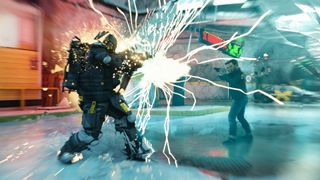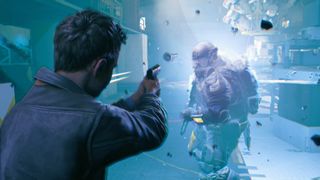
Quantum Break is the answer to a question nobody was actually asking: “What if a game periodically made you stop and watch a 20-minute episode of the kind of sci-fi TV show that doesn’t tend to make it past its first season.” As to why Remedy has decided to provide the answer, you need to look at the game’s provenance. Quantum Break was conceived as an Xbox One exclusive, at a time when that console was still peddling the idea that it might inveigle itself between you and your cable box as the facilitator of everything watched and played in the living room. In that hypothetical—and, let’s face it, hugely optimistic—world a blend of action game and TV series made a sort of sense.
So the question today is does Quantum Break’s high concept structure still make sense now that the Xbox One has all but abandoned its multimedia pipe dream and the game is coming to PC, (much to the hilarious consternation of this console owner). My answer, having played about an hour and half at a preview event last week, is: yeah, sort of. What’s good about Quantum Break is very much the same thing that was good about Remedy’s previous games. What the studio does well is take juicy slices of pop culture—hard-boiled noir for Max Payne, Stephen King-style horror for Alan Wake—and smushes them into fun third-person action shells.

And remember that Remedy is no stranger to cutesy storytelling devices, from Max Payne’s graphic novel cut scenes to Alan Wake’s spin-off series, Bright Falls. But for Quantum Break they’ve gone all in on live action. The cast includes Lost’s Dominic Monaghan as William Joyce, the time travel scientist brother of Jack Joyce, X-men’s Shawn Ashmore, his less smart but more shooty brother. Game of Thrones’ Aiden Gillen plays Paul Serene, the tech bro baddie whose good intentions for the time machine barely last five minutes, and who must hold the record for most polygons devoted to sneer-smiling. They’re joined by Fringe’s Lance Reddick as the kind of sharp-suited moral blank that always seems to run blue chip companies in this kind of show.

The version of Quantum Break I played was on PC, but only playable using controller because keyboard and mouse was still being worked on. It was also running at 30fps, but Remedy told me they will definitely hit 60fps in the remaining weeks of development. What might not change is that VSync must be enabled, a result of the game being built as a Universal Windows Platform app. Listening to Microsoft at the event, it’s clear they’re aware that this is a frustration to developers, and it sounds like change will be coming. On the upside, it does mean your progress will be saved between Xbox One and PC, if for some reason you want to switch platforms. (The Xbox One version of the game comes with a PC key.)
The fictional Riverport University provides the backdrop for the beginning of the game, where Serene has dragged Jack back from gallivanting around Asia to bring his brother in line before Monarch Corporation’s investors get cold feet over William’s dire warnings that the machine they’ve boshed together will end all time entirely. Bad news for the share price, and bad news for the people who are on the can when it happens. Anyway, [very mild spoiler ahead], explodey disaster quickly ensues, leaving Jack and Serene juiced up with new abilities and time disintegrating in the form of some fancy visual effects and periodically frozen bystanders.
Jack’s escape from the University gives you a chance to roadtest his new powers, and it’s here the game transitions from schlocky curio to something close to compelling. The feel of third-person shootouts is remarkably hard to get right. Movement and aiming are often way too wooly, or the whole thing is ruined by a capricious lock-on system. Quantum Break’s combat isn’t perfect—the automated approach to taking cover behind waist-high objects didn’t seem reliable—but it is fun. The guns are the usual mix of SMGs, assault rifles, pistols and shotties, but they feel snappy and impactful.
What really makes the combat interesting, though, is Jack's ability to play around with time. I unlocked three main powers, starting with ‘Time Stop’. This places your enemy in a bubble of frozen time. Shoot bullets at him and they’ll stack up at the edge. When it pops the bullets all hit at once, which feels indecently satisfying.

Next came ‘Time Dodge’. This is like a deluxe version of Max Payne’s slo-mo diving. Jack essentially speeds up time for himself, enabling you to juke past enemies and then unload on them. It’s the kind of move which skilled players will be able to chain into cool combos. Then there’s ‘Time Shield’ which puts you in the freeze bubble, providing a few seconds of respite, although I think you need to be aware of bullets stacking outside and exit accordingly.
The biggest gaming news, reviews and hardware deals
Keep up to date with the most important stories and the best deals, as picked by the PC Gamer team.
Aside from combat, Jack can also use his abilities to solve some (rudimentary, so far) puzzles. One section required him to slow the descent of an elevated platform using a bubble, for instance. He can also use a Time Vision effect that’s much like Assassin’s Creed’s Eagle Vision to identify objectives, and you’ll see echoes of events which happened earlier to help push the story on.
Speaking of which, once I’d shot through a couple of football team’s worth of hired mercs, I triggered the first of the game’s “Junction” decisions. Here control actually switches to Serene, and you're presented with two options in terms of how to progress your evil empire. The first will always be “PR”, and involves taking a more cunning approach to manipulating Riverport’s population. The second will be a “Hardline” choice, and results in brutal-but-effective methodology that makes the citizens increasingly angry about your operation.
Sir, it's a public relations disaster...
Having opted for the PR option, reasoning that public relations is the true evil in 2016, the first live action episode began. During each complete playthrough you’ll make four junction decisions, each with the PR/Hardline choice. Without seeing how they interlock it’s hard to say how much replay value seeing the alternative choices is likely to hold. Remedy did mention that scanning certain narrative objects during the game part of the game will lead to extra clips being added to the subsequent episode, but I still wonder about how jarring it’s going to feel to stop interacting for 20 minutes while the actors do all the acting.

I suppose it’ll come down to how into the story you are. Hideo Kojima has proved that fans will sit through crazy long cut scenes if they’re digging the characters. But equally, the lesson from Metal Gear Solid is that non-believers will reject overlong exposition like a hastily-transplanted cyborg lung. As for the quality of Quantum Break’s live action, well, it’s pretty much as you’d expect. Which is to say just about broadcastable on one of the lesser networks in an unwanted slot on the schedule. Money’s clearly been spent here—the episode I saw culminated in a decently directed car chase—but at the same time your brain can’t help compare it with proper TV shows. And the comparison is inevitably unflattering.
It's the narrative equivalent of the uncanny valley
Something that also struck me as weird is the inherent dissonance between the over the top stuff the characters get up to in-game and then seeing the real life actors responding later in the show. The massacre at the University must leave at least thirty of Monarch’s hired goons dead. But in the episode that follows, we see main merc guy go back to visit his wife at home and he’s basically like: “Yeah, rough day for me at the office.” I dunno, I guess I would be more: “Shit was CRAZY. Dude was lighting my guys up with time magic. Start packing your bags while I write this resignation email.” It’s the narrative equivalent of the uncanny valley. The more real you to try to make the presentation, the clearer the inconsistencies become.
Nonetheless, I went into Quantum Break not quite sure how it worked, and not all that interested in another time travel yarn. But I’d forgotten how enjoyable Remedy’s romps are. This is a studio that makes B-games in the best sense of the description. There’s nothing wrong with a ridiculous sci-fi story so long as your involvement in it feels like a blast. Questions linger over the wisdom of jamming live action into a game in such big chunks, but my hope is the combat continues to feel like a fresh spin on Max Payne’s dodge-and-gun goodness. We’ll know when Quantum Break arrives on 5th April.
With over two decades covering videogames, Tim has been there from the beginning. In his case, that meant playing Elite in 'co-op' on a BBC Micro (one player uses the movement keys, the other shoots) until his parents finally caved and bought an Amstrad CPC 6128. These days, when not steering the good ship PC Gamer, Tim spends his time complaining that all Priest mains in Hearthstone are degenerates and raiding in Destiny 2. He's almost certainly doing one of these right now.
Most Popular





